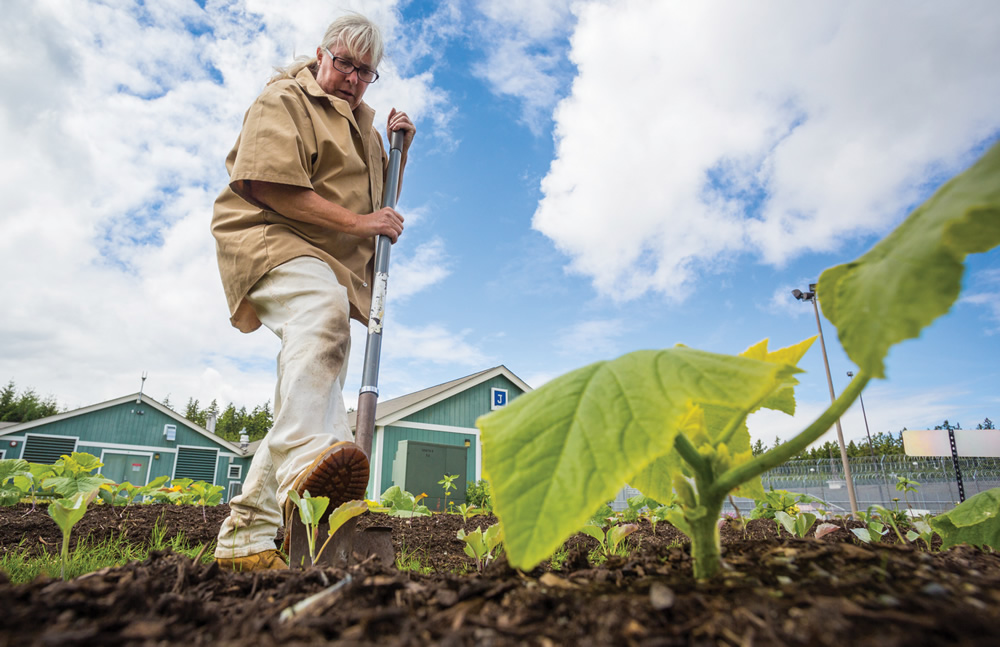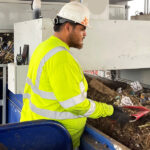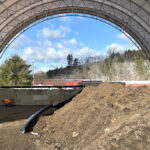Started in 2003, Washington State’s Sustainability In Prisons Project operates 113 programs — from energy efficiency to composting — with approximately 3,000 inmate participants from all 12 prisons across the state.
K. Bush, J. Vanneste, D. Pacholke, J. Trivett, S. Sinclair and E. Heinitz
BioCycle September 2015
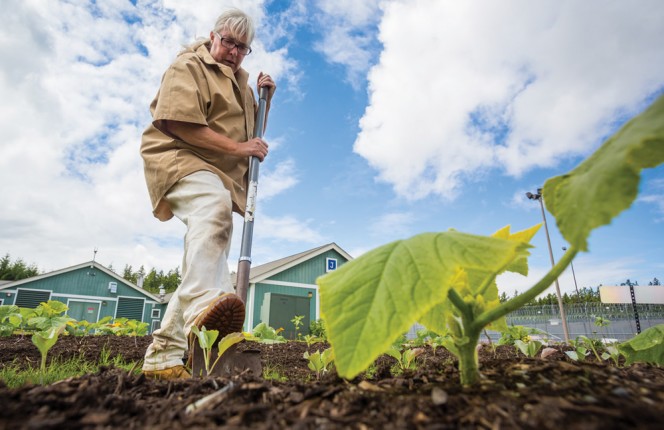
All compost produced at the correctional facilities is used to improve soil in prison gardens (inmate working in a garden). Photo by Benj Drummond and Sara Joy Steele
The Sustainability in Prisons Project (SPP) is a partnership founded by the Washington State Department of Corrections (WDOC) and The Evergreen State College (Evergreen) to bring science, nature, education and sustainable operations into prisons. Through diverse collaborations, SPP reduces the environmental, economic and human costs of prisons. Its programs bridge the divide between people living and working in corrections centers, and the social and ecological communities outside the fences. Examples of SPP programs include: composting, recycling, ecological restoration and research, bicycle restoration, gardening, rearing threatened and endangered animals and plants, and environmental literacy education.
More than 17,000 adults are incarcerated in Washington State prisons, and 97 percent of these men and women will return to communities in the state. SPP programs provide opportunities to contribute — doing good while serving time. WDOC’s and Evergreen’s experience demonstrates that most incarcerated individuals are eager to receive education and training, and to find creative solutions to significant environmental challenges.
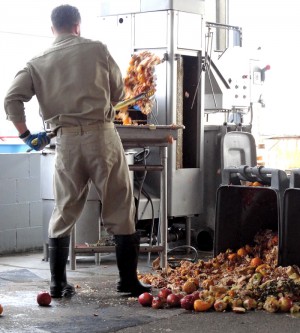
In 2014, WDOC composted more than 1,900 tons of food waste. At one prison, food waste is shoveled into a pulper by an inmate and then transported by staff to a composting center. Photo by John Dominosk
SPP began as an informal endeavor at Cedar Creek Corrections Center in Washington State in 2003 on a small scale, with equipment and materials primarily sourced from repurposed and salvaged items. Successful establishment of composting and water catchment programs laid the foundation for more complex science and sustainability education and training programs. SPP grew surprisingly quickly, now operating 113 programs with approximately 3,000 inmate participants from all 12 prisons across Washington State, and more than 50 partner organizations.
SPP programs are defined by five Essential Components: Bringing nature “inside”; safe and sustainable operations; engagement and education; partnerships with multiple benefits; and evaluation and dissemination. With the Essential Components as a guide, SPP operates four program areas: education and training, community contributions, science and conservation, and sustainable operations. Many SPP programs fit within more than one program area. This article focuses on sustainable operations programs including water conservation, energy conservation, fuel use reduction, green building, and waste reduction. In collaboration with many partners, sustainable operations programs increase facility sustainability, offer low-cost education and training opportunities to inmates and staff, and reduce operating costs.
Water
Multiple, ongoing efforts are in place to conserve water in prisons. Each facility’s water needs, availability and ecoregion are considered to identify appropriate programs, project design, irrigation, landscaping, and water conservation opportunities. Several prisons have small-scale rainwater catchment systems. Low flow toilets and showers are standard features in all WDOC facilities. Some facilities with onsite wastewater treatment plants use reclaimed water for maintenance and equipment wash down at the wastewater treatment plant. At one facility, purple pipe has been installed in anticipation of future connection with the neighboring municipal wastewater treatment facility. At a second facility, reclaimed water has been brought to the doorstep and funding has been requested to install the piping throughout the institution. Comparing 2009 with 2014, annual potable water use decreased by over 100 million gallons.
Energy
Energy costs associated with conventional prison operations are significant. Reducing energy consumption, identifying energy conservation and alternative energy projects with acceptable payback periods, and initiating programs with valuable education and training opportunities are ongoing priorities. The greatest energy savings result from lighting and equipment monitoring, maintenance and upgrades. Energy intensive lighting is steadily being replaced with LED fixtures and bulbs, saving energy while reducing staff time required to replace bulbs. Heat recovery units are installed on laundry systems to significantly reduce energy consumption needs associated with daily laundry. Proactive facility maintenance has resulted in cost avoidance, improved building performance, reduced energy consumption and asset preservation.
Energy Service Company (ESCo) projects are a cost-effective way to complete energy upgrades to aging buildings and a means to use utility savings for the project expenses. (An ESCo provides a broad range of energy solutions including designs and implementation of energy savings projects, retrofitting, energy conservation, energy infrastructure outsourcing, power generation and energy supply.) Rebates associated with successful ESCo projects have saved hundreds of thousands of dollars per project, while smaller-scale utility incentives save tens of thousands of dollars per project. Decentralizing the heating system at one prison brought in $500,000 in energy incentives and a guaranteed annual utility savings of $244,000.
Alternative energy projects help WDOC achieve energy conservation goals. Rooftop solar panels were installed at the Coyote Ridge Corrections Center food factory. A project is planned to recover waste heat from the sewer at Clallam Bay Corrections Center, which will serve as model for other Washington prisons. Even though it is not terribly impactful to overall energy consumption profiles, SPP is partnering with academic and nonprofit organizations to install small-scale alternative energy sources to demonstrate technologies. Comparing 2005 with 2014, total facility heating and energy consumption has decreased by 23 percent.
Fuel Reduction
SPP has seen a steady downward trend in transportation fossil fuel use since 2009. This is a result of expanding use of biofuels for vehicles and equipment, and making targeted investments in electric and hybrid vehicles, including diesel-electric hybrid buses for inmate transport. SPP is transitioning to an all-electric fleet inside the prison perimeter, while piloting use of electric vehicles for outside perimeter patrol. Operational changes limiting staff travel and more efficient scheduling for offender transports also contribute. Power equipment use is being reduced where applicable, and hand push mowers are utilized at some facilities. Since 2009 transportation fuel consumption has been reduced by 35 percent.
Green Building
Prison facilities are being built and renovated to meet green standards. The WDOC now has 40 LEED® certified buildings and more on the way. Coyote Ridge Corrections Center is the first prison campus in the nation to receive LEED® Gold certification. Based on performance measures, investments in high performance buildings appear to be paying off. Data indicates that the LEED Gold facility is performing 36 percent more efficiently than a similar sized facility lacking high performance construction features. In addition, inmates are receiving green building education through prison vocational programs offered in partnership with Washington State Community and Technical Colleges.

All 12 Washington prison facilities are invested in waste sorting and recycling. About 2,000 tons/year are recycled, including corrugated. Photo by Benj Drummond and Sara Joy Steele
Waste Reduction
Primary waste reduction initiatives, begun in 2005, are waste sorting and recycling programs, environmentally preferred product purchasing, and composting. In 2005, the first year of tracking, 7,479 tons of waste were landfilled. By 2014, landfill waste was limited to 3,325 tons, a 56 percent reduction.
All 12 Washington prison facilities are invested in waste sorting and recycling; currently, about 2,000 tons are recycled annually. Three of the largest WDOC prisons have conveyor belt “pick lines” to help with large quantity waste sorting; the nine other prisons have upstream sorting programs. Green purchasing policies and practices are improving and potential purchasing and operational changes are continually evaluated, such as eliminating use of trash bag liners, and using durable items in place of disposable.
In 2014, WDOC composted more than 1,900 tons of food waste, 4.5 times more than in 2009. Current composting programs include a range of approaches including small and large-scale vermicomposting, large-scale in-vessel, and small-scale low-tech static pile (see “Correctional Facility Composting In Washington State,” August 2013 for program details).
SPP has multiple vermicomposting programs throughout the state. Small-scale demonstration worm bins associated with prison gardens provide education, soil amendment and demonstrate composting methods easily replicated on a home-scale. Two Washington prisons are operating large-scale vermicomposting programs with bins constructed from repurposed materials such as old mattress components. At Monroe Corrections Complex (MCC), inmate technicians carefully monitor the vermicomposting program that processes over 49 tons/year of food waste, diverting about 10 percent from the food waste stream. The MCC program is also piloting use of anaerobic fermentation to initiate decomposition of postconsumer food wastes such as meat and dairy. The resulting partially-processed material is finished by vermicomposting. Thus far, the combination of anaerobic decomposition and vermicomposting appears to be a promising composting method for the prison.
With a few exceptions, the majority of current composting systems are large in-vessel composters. The earliest in-vessel system was installed at Larch Corrections Center in 2004. Drum style in-vessel systems are in use at four facilities with installation of a fifth system pending. These include DT Environmental’s EnviroDrum system at the Cedar Creek and the Washington Corrections Centers. Mission Creek Corrections Center for Women is using low-tech static turned piles, an approach that provides an excellent opportunity to learn home-scale composing techniques. The only WDOC facility without an in-facility composting program sends waste to an off-site composting facility nearby.
All compost produced is used to improve soil in prison gardens. In Washington State, 11 of the 12 prisons have flower and vegetable gardens. Gardens reduce the prison’s carbon footprint, teach inmates gardening skills, offer opportunities for therapeutic benefits, and provide fresh vegetables for inmates and/or food bank donations. In 2014, more than 170,000 pounds of fresh vegetables were grown in Washington prisons.
Related Program Components
Education
Educational offerings for inmates and staff are continually being added. Programs are described by interpretive signs and plaques throughout most correctional facilities. Currently, two prisons offer monthly science and sustainability lectures on topics such as recycling, composting and energy conservation. Roots of Success is a 50-hour environmental literacy course offered in nearly every Washington prison. The curriculum includes modules on water, waste, transportation, energy, building, and more. SPP is developing a new program in partnership with Seattle Tilth to provide Master Recycler Composter certification for incarcerated adults and corrections staff. Inmates will receive training and certification that may be translated into academic credit post-release.
Tracking, Reporting, and Policy
Every prison tracks resource use, setting goals, reporting progress, and setting goals again. In early 2015, WDOC launched an online database for tracking sustainable operations, with results viewable and comparable statewide. Information for each facility is compiled, making tracking and reporting more efficient. With better tracking, new goals and projects can be identified.
A new WDOC sustainability policy was adopted in winter 2015, and is already yielding helpful results. The policy formalizes the role of SPP within WDOC, establishes a sustainability team at each prison, and requires mandatory waste audits at each facility twice a year. The first biannual waste audit was conducted in early 2015. When waste audits were initiated, it was planned to target reduction of single use plastics; however, early results indicate less of these plastics than expected are in the waste stream. SPP is exploring replacement of single use items with durable, environmentally-preferred, or recyclable options.
SPP Network
Given interest in its programs from other countries and at least 28 other states, SPP launched the SPP Network in 2012. It is currently housed at The Evergreen State College, and there are seven other programs fully implemented using the SPP model. SPP is benefiting from the innovative ideas generated by new programs, and the network serves as a hub to connect them with resources and referrals.
On a quest to continually improve sustainability in Washington prisons, SPP is working on a new plan to outline system-wide goals over the next two years. A green track job program is being created to provide inmates opportunities to participate in progressive green job and education programs and to build impressive resumes in sustainability. Voluntary, inmate led “think tanks” are being developed to propose projects and help solve sustainability challenges.
The potential to collaborate with inmates, corrections staff, and others to identify appropriate, mutually beneficial prison sustainability programs is vast. And the education and training received through SPP programs can be beneficial post-release. Given the proper resources, prisons can be centers for science education and ecological research, models for sustainability, and hubs of collaboration.
Kelli Bush is Program Manager, and Joslyn Trivett is Network Manager, of the Sustainability in Prisons Project (SPP). Julie Vanneste is Sustainable Operations Manager, Washington Department of Corrections (WDOC) and SPP. Dan Pacholke is Deputy Secretary, WDOC and SPP Senior Advisor. Eric Heinitz is with WDOC’s Environmental & Regulatory Compliance office.


